It Begins: AMD Announces Its First ARM Based Server SoC, 64-bit/8-core Opteron A1100
by Anand Lal Shimpi on January 28, 2014 6:35 PM EST- Posted in
- CPUs
- IT Computing
- AMD
- Arm
- Opteron
- Enterprise
- Enterprise CPUs
- Opteron A1100
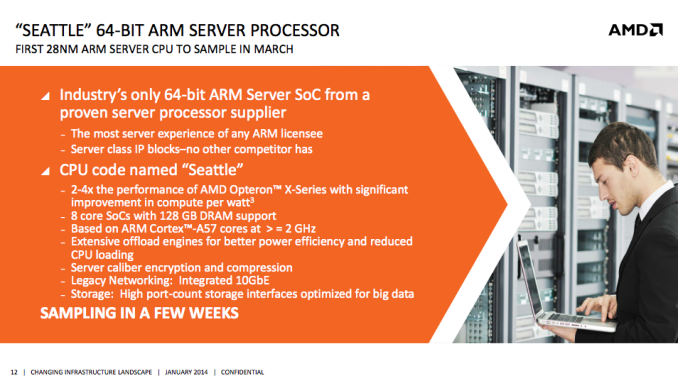
Around 15 months ago, AMD announced that it would be building 64-bit ARM based SoCs for servers in 2014. Less than a month into 2014, AMD made good on its promise and officially announced the Opteron A1100: a 64-bit ARM Cortex A57 based SoC.
The Opteron A1100 features either 4 or 8 AMD Cortex A57 cores. There's only a single die mask so we're talking about harvested die to make up the quad-core configuration. My guess is over time we'll see that go away entirely, but since we're at very early stages of talking about the A1100 there's likely some hedging of bets going on. Each core will run at a frequency somewhere north of 2GHz. The SoC is built on a 28nm process at Global Foundries.
Each pair of cores shares a 1MB L2 cache, for a total of up to 4MB of L2 cache for the chip. All cores share a unified L3 cache of up to 8MB in size. AMD designed a new memory controller for the Opteron A1100 that's capable of supporting both DDR3 or DDR4. The memory interface is 128-bits wide and supports up to 4 SODIMMs, UDIMMs or RDIMMs. AMD will be shipping a reference platform capable of supporting up to 128GB of Registered DDR3 DIMMs off of a single SoC.
Also on-die is an 8-lane PCIe 3.0 controller (1 x8 or 2 x4 slot configurations supported) and an 8-port 6Gbps SATA controller. AMD assured me that the on-chip fabric is capable of sustaining full bandwidth to all 8 SATA ports. The SoC features support for 2 x 10GbE ports and ARM's TrustZone technology.
AMD will be making a reference board available to interested parties starting in March, with server and OEM announcements to come in Q4 of this year.
It's still too early to talk about performance or TDPs, but AMD did indicate better overall performance than its Opteron X2150 (4-core 1.9GHz Jaguar) at a comparable TDP:
| AMD Opteron A1100 vs. X2150 | |||||||||
| CPU Core Configuration | CPU Frequency | SPECint_rate Estimate | SPECint per Core | Estimated TDP | |||||
| AMD Opteron A1100 | 8 x ARM Cortex A57 | >= 2GHz | 80 | 10 | 25W | ||||
| AMD Opteron X2150 | 4 x AMD Jaguar | 1.9GHz | 28.1 | 7 | 22W | ||||
AMD alluded to substantial cost savings over competing Intel solutions with support for similar memory capacities. AMD tells me we should expect a total "solution" price somewhere around 1/10th that of a competing high-end Xeon box, but it isn't offering specifics beyond that just yet. Given the Opteron X2150 performance/TDP comparison, I'm guessing we're looking at a similar ~$100 price point for the SoC. There's also no word on whether or not the SoC will leverage any of AMD's graphics IP.
The Opteron A1100 is aimed squarely at those applications that either need a lot of low power compute or tons of memory/storage. AMD sees huge demand in the memcached space, cold storage servers and Apache web front ends. The offer is pretty simple: take cost savings on the CPU front and pour it into more DRAM.
Early attempts at ARM based server designs were problematic given the lack of a 64-bit ARM ISA. With ARMv8 and the Cortex A53/A57 CPUs, that's all changed. I don't suspect solutions like the Opteron A1100 to be a knockout success immediately, but this is definitely the beginning of something very new. Of all of the players in the ARM enterprise space, AMD looks like one of the most credible threats. It's also a great way for AMD to rebuild its enterprise marketshare with a targeted strike in new/growing segments.
AMD's Andrew Feldman included one of his trademark reality check slides in his Opteron A1100 presentation today:
Lower cost, high volume CPUs have always won. That's how Intel took the server market to begin with. The implication here is that ARM will do the same to Intel. Predicting 25% of the server market by 2019 may be feasible, but I'm not fond of making predictions for what the world will look like 5 years from now.
The real question is what architecture(s) AMD plans to use to get to a leadership position among ARM CPUs and a substantial share of the x86 CPU market. We get the first hint with the third bullet above: "smaller more efficient x86 CPUs will be dominant in the x86 segment".


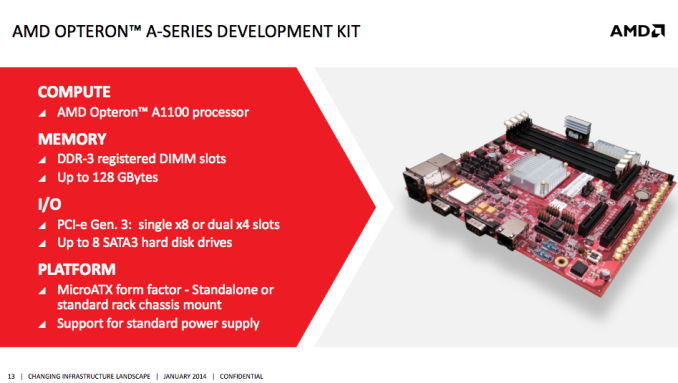
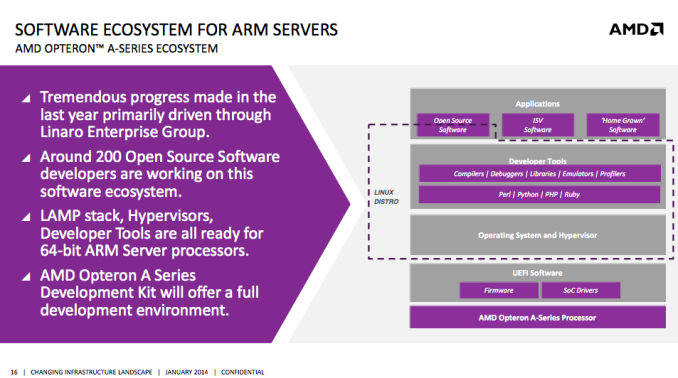
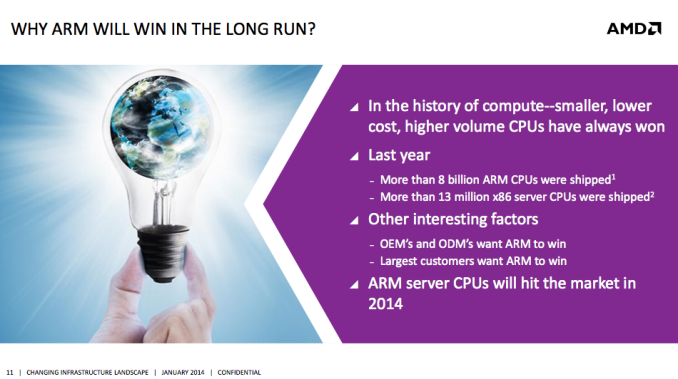
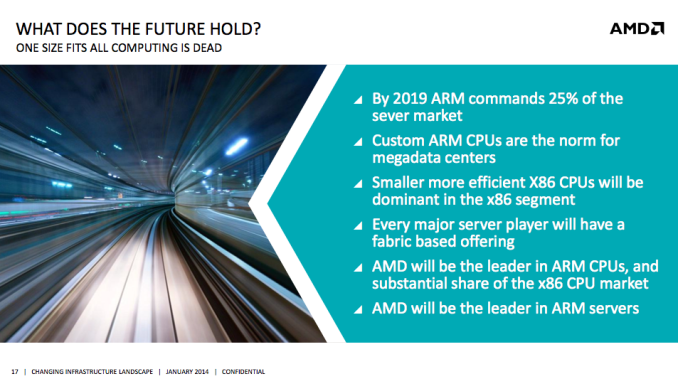








122 Comments
View All Comments
factual - Friday, January 31, 2014 - link
There is nothing to discuss regarding the price since AMD has not released any official prices.1. Many mainstream apps (written as recent as 2014!) have ISA-specific code and optimizations, that's a well known, undisputed fact! The failure called Windows RT is a proof of this. Majority of x86 software (e.g. adobe CS6) are not available for Windows RT. As a person who works in an enterprise Linux environment, I know first hand that majority of linux pro apps are not available for ARM and will not be available anytime soon! Even the enterprise distro that we use (SLES) is not available for ARM!
2. According to this article, AMD claims that their upcoming ARM-based Opteron A1100 scores 80 in SPECint_rate benchmark at 25W TDP; now this is just a claim for a product that hasn't been released yet, in the mean time, Intel's already released Avoton scores 106 in SPECint_rate benchmark at 20W TDP! So basicaly, by the time this chip comes out, Intel's older generation chip will have a 60% perf/watt advantage over it!! By that time, Intel will have release a newer 14nm atom chip which will have an enormous perf/watt advantage over this AMD chip
3. No, I am not. Intel already demonstrated a 14nm broadwell chip with over 30% power reduction compared to 22nm haswell. According to Intel, 14nm will also bring huge density reductions which translates into cheaper chips; and unlike TSMC and other foundries, Intel has a pretty good record of making accurate claims about their upcoming process technology.
ARM is not an open ISA! it's 100% proprietary same as x86. The only difference is that, unlike Intel, ARM is willing to license it's ISA (architectural license) as well as its soft and hard IPs to any company who pays the license fee. The claim that ARM ISA is somehow inherently superior to x86 in terms of power consumption is patently false! these claims are marketing bs often made by people who have little or no technical knowledge. You keep repeating the word "arch", I think you don't understand the difference between ISA and uarch (microarchitecture). What determines the
factual - Friday, January 31, 2014 - link
You keep repeating the word "arch", I think you don't understand the difference between ISA and uarch (microarchitecture). What determines the performance and power efficiency of a cpu core is it's microarchitecture and manufacturing technology; The ISA the cpu core was designed for, has negligible effect on its perf/watt.ScouserLes - Saturday, February 1, 2014 - link
According to Intel, the SPECint_rate for Avoton is an estimate. They did not use the SPEC 2006 benchmark software. Instead, they used a range of different benchmarks, including Antutu, and calculated a geomean. Software and workloads may have optimised.I wonder why Intel didn't just run the SPEC 2006 benchmark suites, and publish them. In view of the Antutu fiasco last year, I'm taking this estimate with a pinch of salt until a verified SPEC 2006 result is available.
Guspaz - Wednesday, January 29, 2014 - link
Isn't this basically an admission that AMD can't design low-power parts with competitive performance? Keveri's terrible CPU performance is mitigated by good graphical performance, but graphical performance has no relevance for enterprise use, leaving you with simply a terrible CPU. Releasing low-power server CPUs with CPU cores designed by ARM instead of AMD seems to me to be admitting to this.KenLuskin - Wednesday, January 29, 2014 - link
Maybe you should read about MULLINS chip that AMD will be delivering in Q2.It is better than Baytrail as measured by PCmark 8, and is 250% better in graphics!
Guspaz - Wednesday, January 29, 2014 - link
OK, then... why are they using a Cortex A57 instead of an in-house CPU?darkich - Thursday, January 30, 2014 - link
And they are both embarrassed by nvidia.The K1 reaches over 350GFLOPS, compared to ~ 65 GFLOPS of the Bay Trail !
Other ARM GPU's are also superior to both AMD and Intel solutions. Read about Mali t760 and PowerVR series 6 XT
tuxRoller - Thursday, January 30, 2014 - link
What are you taking about?For one thing that GFLOPS is almost certainly for the GPU. The CPU is apparently not even armv8 but a cortex a15 r3 (http://www.tomshardware.com/reviews/tegra-k1-keple... So they are going to be slower, clock for clock, than the cortex a57.
darkich - Friday, January 31, 2014 - link
I was talking about the GPU :pAs is clearly stated in my post
tuxRoller - Saturday, February 1, 2014 - link
It was a bit ambiguous given the thread context (CPU), but I see you did say in the second paragraph "Other ARM GPUs...". I suppose I needed to analyze it a bit more.Still I'd expect nvidia to be trailing both IMG and Qualcomm as usual, especially in power consumption.
The problem is that IMG had been doing this for so long and make amazingly capable GPUs (along with owning tons of mobile graphics related patents) and Qualcomm had been hugely improving the bit boys designs they bought from amd with their tremendous engineering talent (and SUBSTANTIALLY larger budget given the company is more than an order of magnitude larger than nvidia).
It's going to be hard for nvidia to compete, and this far that's how its been.